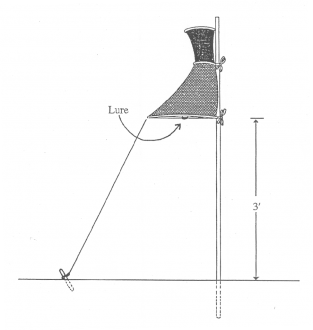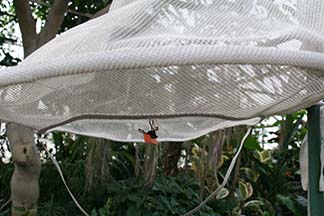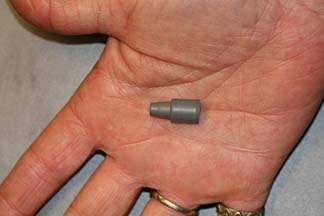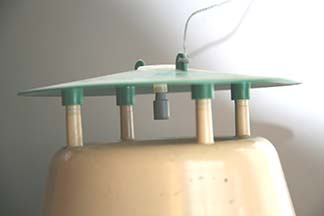Corn Earworm Traps
When
Begin monitoring for corn earworm in late June or early July. You want to have the trap up and running before any of your corn is in fresh silk stage. When there is no more sweet corn in fresh silking stage, monitoring can cease. For most growers, this is some time in September. Sunlight gradually makes the trap brittle, so removing it from the field promptly when it is no longer needed, and storing it away from sunlight will significantly lengthen its useful life.
Where
Correct placement is important. The moths find the trap by smell, so prevailing wind direction is a factor. The trap should be in a slight opening, preferably within the sweet corn field. Another good placement would be at the edge of the sweet corn field, so the scent of the lure will be carried into the corn on the wind. Edges close to woods are not good sites, since the trees block and deflect breezes. Obstructions to equipment (boulders, stump piles, telephone poles) within the field are good spots to set the traps because they leave openings that are easy to find and allow the scent to move freely through the sweet corn. Also, spaces between plantings can be good if the trap is not in the way of farm equipment.
Keep down the growth of plants under the trap. If growth gets higher than about one foot, it can reduce trap effectiveness.
Trap type
We use the white dacron net Heliothis trap manufactured by Scentry. It is relatively large, and has a line that goes from the lower edge to a stake in the ground. Avoid hitting the trap, support pole, or the line and stake with field equipment.

How
The diagram shows proper placement. If a conduit pipe is used for support, you may want to add duct tape over the tie points to prevent the trap from sliding downwards. The bracing line that goes to a stake in the ground should be slightly slack. It just provides some support for windy conditions. Distance from the ground to the trap bottom should be about three feet.
Optional: Unwrap a fumigant strip and place it in the upper section of the trap. To avoid touching the lure with fingers, or having it directly rest on the trap, place it in a paper towel. Adding a light plastic bag inverted over the top (not the entire trap!) section will help keep the fumes contained and the catch dry. There are positive and negative aspects of using fumigant strips in the trap. Positive: the strip kills the moths before they beat up their wings, simplifying identification. Negative: the strip is toxic, and can weaken the fabric of the trap, if it is in direct contact. Experienced scouts leave out the strip, but have to count the moths alive. Occasionally some get away before they can be identified.
Place the pheromone lure in the middle of the opening at the bottom - not hanging several inches below or above the opening. We have used several devices for securing lures in the position - safety pins, clothes pins, and small binder clips. The important thing is that it stay in the correct position despite wind and weather, and that it be easy to change lures. The lure in the photo below is the red-brown object in the binder clip.
Lure type
Use Hercon brand corn earworm lures (“luretapes”). We do not recommend other types. Lures can be purchased from Great Lakes IPM. The field life of each corn earworm lure is two weeks. Purchase only enough lures for one season, since they lose potency when stored. Store unused lures in a sealed container in refrigerator or freezer. Lures stored in warm or hot conditions will rapidly lose potency…and you will not know it.

Checking
Check the trap and record results according to your needs. We suggest a schedule of twice per week if you are to benefit from monitoring. These moths fly at night, so very few, if any, moths will be caught during the day. Do not discard old lures or lure packaging on the ground. It could interfere with your trap.
Fall Armyworm Traps
When
We suggest starting your fall armyworm trapping no later than mid-July. The trap should be running when sweet corn is present but before fall armyworms are expected. Fall armyworms can attack sweet corn at any stage of growth, so monitoring usually continues until shortly before the last harvest of the season.
Where
Correct placement is important. The moths find the trap by scent, so the prevailing wind direction is a factor. You want to place the trap so that the scent of the lure will travel into the sweet corn field. Keeping the trap among or immediately downwind of pre-silking corn is desirable. For some farms, this means moving the trap part way through the season. An ideal spot is at the edge of the planting, but out of the way of equipment. We place many traps next to obstacles the tractor must go around — telephone poles, boulders, stumps. Avoid field edges with thick, tall trees or other wind barriers. They disrupt the breezes and create pockets of low air movement on their downwind sides.
Keep plant growth below the trap to two feet or less. Taller growth can reduce trap effectiveness.
Trap Type
We use a bucket-style trap, called a universal moth trap (“unitrap”). WARNING: traps with yellow sections attract and kill very high numbers of bumble bees. Other colors don’t have this problem. We spray painted our yellow traps with tan, and greatly reduced this problem, but still had some bees die (yellow color still showed a bit to them?).
Lure
We recommend the 4-component fall armyworm lure by Scentry. Each one lasts 4 weeks in the field.
How
Using a 7 ½ foot length of conduit pipe, make a 90° bend eight inches from the top. Drill a hole for the supporting wire approximately ½ inch from the tip. In the field, decide on the location and drive a similar diameter pipe into the ground about 12 to 18 inches. Then remove it and place the conduit in the hole. This avoids damaging the conduit pipe. The bend should be around 5 ½ feet above ground. Use a short length of flexible wire to support the trap. It has two holes in the roof section, to accommodate the wire. Trap height should be around 4 ½ to 5 feet above ground.

Note the photo below. Place the lure (gray object in the center of the photo) so that it is in the opening immediately below the center of the roof of the trap. Different models have different methods of affixing the lures. Recent models have a small plastic “basket” to hold the lure in the correct position, and allow the odor to dissipate properly. In older versions (photo next page) the narrow end of the lure is stuck into a molded plug that fits into the roof. Other times we pierce the lure with a safety pin and hang it in position on a short string, which is itself held by the plug. A fumigant strip is helpful for this trap. Unwrap it and place it inside a paper towel in the trap bottom. The towel keeps fingers away from the fumigant, and absorbs moisture that finds its way inside the trap.

Checking
Check the trap and record the results according to your own schedule and needs. We suggest a schedule shorter than every seven days, if you are to get the full benefit of monitoring. Fall armyworm moths fly at night so very few if any will be caught during the day. Most lures for fall armyworm are effective for about two weeks. Do not discard old lures or packaging on the ground. It can interfere with the effectiveness of your trap

European Corn Borer Traps
Using traps to monitor European corn borer (ECB) is not as critical as it is for fall armyworm or corn earworm. ECB is much more predictable than either of the others. Also, it is easy to determine ECB infestation in the late whorl stage, by scouting. If you plan to use ECB traps, it is best to use two of them, one baited with the “New York” strain lure, and the other baited with the “Iowa” strain lure. Both types occur here, with the New York strain predominating, especially in southern New Hampshire.
When
Trapping for ECB begins before either of the other species. There are two generations here. In southern NH, the two generations are separated by 7-14 days of very low or zero catch. In the Lakes region and farther North, the two meld together into one long, uninterrupted catch period. Begin trapping in early June. You can stop trapping in mid-September. We use the same white dacron net trap that is for corn earworm, so removing it from the field promptly when it is no longer needed, and storing it away from sunlight significantly lengthens its useful life.
Where
Correct placement is important. The moths find the trap by smell, so prevailing wind direction is a factor. The trap should be in a slight opening, preferably within the sweet corn field. Another good spot would be the up-wind edge of the sweet corn field, so the scent of the lure will be carried into the corn. Edges close to woods are not good sites, since the trees block and deflect breezes. Obstructions to equipment (boulders, stump piles, telephone poles) within the field are good spots to set the traps because they leave openings that are easy to find and allow the scent to move freely through the sweet corn. Spaces between plantings can be good if the trap is not in the way of farm equipment. Sometimes a border of tall (2-4 feet) grasses or annual weeds can be an effective site for the first generation of corn borers. It is important to keep down the growth of plants under the trap. If growth gets higher than about one foot, it can reduce trap effectiveness.
Trap type
We use the white dacron net Heliothis trap manufactured by Scentry. It is relatively large, and has a line that goes from the lower edge to a stake in the ground. Avoid hitting the trap, support pole, or the line and stake, with field equipment.
How
The drawing on page 1 shows proper placement. If a conduit pipe is used for support, you may want to add duct tape over the tie points to prevent the trap from sliding downwards. The bracing line that goes to a stake in the ground should be slightly slack. It just provides some support for windy conditions. Distance from the ground to the trap bottom should be about three feet.
Optional. Unwrap a fumigant strip and place it in the upper section of the trap. Place it in a paper towel, to prevent the strip from touching the fabric or your fingers. Adding a light plastic bag inverted over the top (not the entire trap!) section will help keep the fumes contained and the catch dry. There are positive and negative aspects of using fumigant strips in the trap. Positive: the strip kills the moths before they beat up their wings, simplifying identification. Negative: the strip is toxic, and can weaken the fabric of the trap, if it is in direct contact. Also, it complicates emptying the trap. Experienced scouts leave out the strip, but have to count the moths alive. Occasionally some moths get away before they can be identified.

Place the pheromone lure in the middle of the opening at the bottom— not hanging several inches below or above the opening. We have used several devices for securing lures in the position—safety pins, clothes pins, and small binder clips. The important thing is that it stays in the correct position despite wind and weather, and that it is easy to change lures.
Lure type
Use Scentry brand European corn borer lures. We do not recommend other types. For best results, you will need two traps spaced at least 30 yards apart (so that they don’t interfere with each other); one baited with lures for the “Iowa” strain, and the other baited with lures for the “New York” strain. Lures can be purchased from Great Lakes IPM. The field life of each ECB lure is four weeks. Purchase only enough lures for one season, since they lose potency when stored. Store unused lures in a sealed container in refrigerator or freezer. Lures stored in warm or hot conditions will rapidly lose potency…and you will not know it.
Checking
Check the trap and record results according to your needs. I suggest a schedule of twice per week if you are to benefit from monitoring. These moths fly at night so very few, if any, moths will be caught during the day. Do not discard old lures or lure packaging on the ground. It could interfere with your trap.
Toxicant Strips For Some Traps
We employ toxicant strips (“Vaportape”) which contain a fumigant insecticide called vapona (DDVP). They are required in the bucket traps, and we sometimes use them in net traps. One strip will often last two months or longer in the field. Like other pesticides, they must be used and stored with caution. You may wish to store any unopened strips in a tight jar in your pesticide storage area. They arrive individually wrapped in plastic (below). Remove the plastic covering when it is time to place it in a trap. We often place the lure in a folded paper towel to keep it from contacting the plastic trap.
Storing Lures and Vapor Strips
The lures are designed to release minute amounts of chemicals that mimic sex pheromones of the female moths. You can ruin lures by storing them in a hot place. I recommend storing them in a refrigerator or freezer until ready for use. The toxicant strips are different; they release a fumigant to kill the insects caught in the trap. Never store them with food! Place them in a sealed glass jar, in the pesticide storage area, if it doesn’t get too hot. If you place it in a glass jar, be sure it isn’t in sunlight (it could get hot inside).
Acknowledgements
This publication was supported in part by IPM grants from the New Hampshire Department of Agriculture, Markets and Food, and the National Institute for Food and Agriculture, United States Department of Agriculture.
Thank you to Holly McKinney for retyping much of this from the original 1990 handouts, to Suzanne Hebert for layout and posting. Some of this material was originally written by Don Barry, IPM technician. The two drawings of the net trap and bucket trap are used by permission of Scentry, Inc.
Download the Resource for the complete fact sheet and a printable version.

